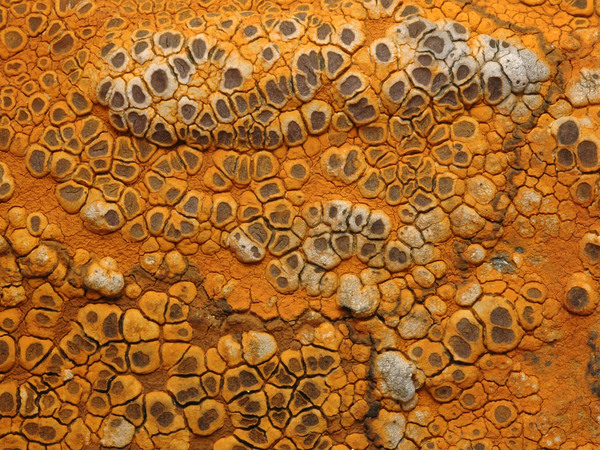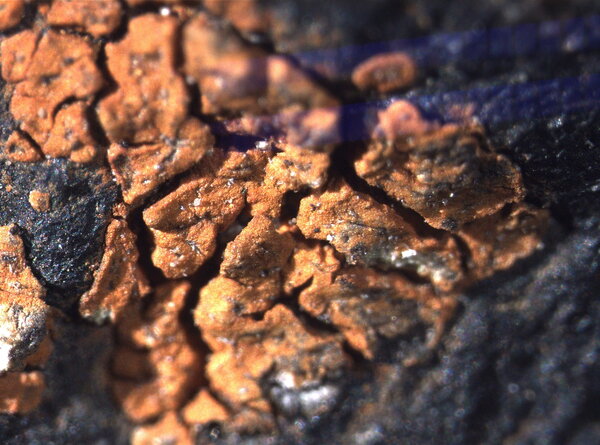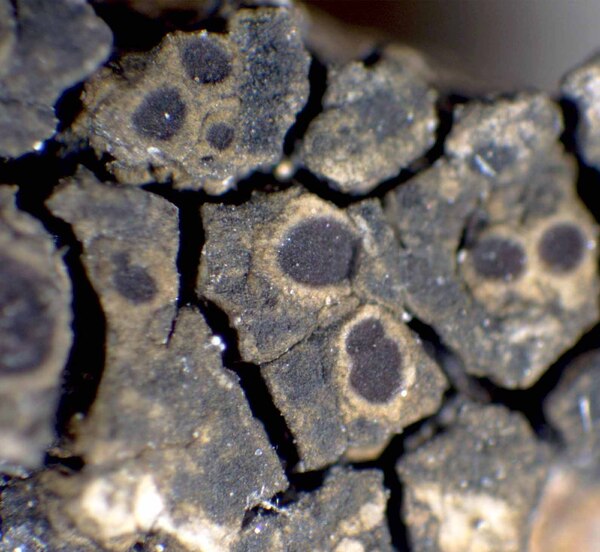Bellemerea diamarta (Ach.) Hafellner & Cl. Roux
in Clauzade & Cl. Roux, Bull. Soc. Bot. Centre-Ouest, n. sér. 15: 129, 1984. Basionym: Urceolaria diamarta Ach. - Meth. Lich.: 151, 1803.
Synonyms: Aspicilia cinerea var. oxydata (Flot.) Anzi; Aspicilia diamarta (Ach.) Boistel; Candelariella ferruginata (Harm.) Zahlbr.; Lecanora cinereorufescens var. diamarta (Ach.) Nyl.; Lecanora diamarta (Ach.) Vain.; Lecanora ferruginata Harm.
Distribution: N - Ven, TAA, Lomb, Piem (Isocrono & al. 2004), VA (Piervittori & Isocrono 1999, Isocrono & al. 2008), Emil. C - Sar. S - Si.
Description: Thallus crustose, episubstratic, rimose areolate, rust-red, sometimes delimited by a pale prothallus. Areoles 0.3-0.8 mm wide, angular, contiguous, mostly flat to slightly convex. Algal layer extending below the hypothecium. Apothecia cryptolecanorine-aspicilioid, immersed in the areoles, 0.2-1.4(-2) mm across, with a concave to slightly convex, black (when dry), or lead-grey (when wet) disc, and a very thin thalline margin. Proper exciple poorly developed, more or less colourless, I+ blue; epithecium reddish brown, N-; hymenium colourless I+ blue; paraphyses branched and anastomosing in upper part, c. 2 µm thick, the apical cells not or only slightly swollen, usually with a thin, dark brown cap; hypothecium colourless, pale I+ blue, Asci 8-spored, clavate, approaching the Porpidia-type, with a less distinct tube structure. Ascospores 1-celled, hyaline, ellipsoid or slightly fusiform, (5-)9-18 x 4-9 µm, the inner wall I+ blue, with a thin halonate epispore. Pycnidia dark, immersed. Conidia short-bacilliform. Photobiont chlorococcoid. Spot tests: thallus K-, C-, KC-, P-. Chemistry: without lichen substances.Note: an arctic-alpine, circumpolar lichen of metal-rich siliceous rocks, with optimum in the Alpine belt; somehow more hygro- and less photophytic than B. alpina; widespread throughout the Italian Alps.
Growth form: Crustose
Substrata: rocks
Photobiont: green algae other than Trentepohlia
Reproductive strategy: mainly sexual
Species of metal-rich rocks
Commonnes-rarity: (info)
Alpine belt: rather common
Subalpine belt: rare
Oromediterranean belt: extremely rare
Montane belt: absent
Submediterranean belt: absent
Padanian area: absent
Humid submediterranean belt: absent
Humid mediterranean belt: absent
Dry mediterranean belt: absent

Predictive model
Herbarium samples
Growth form: Crustose
Substrata: rocks
Photobiont: green algae other than Trentepohlia
Reproductive strategy: mainly sexual
Species of metal-rich rocks
Commonnes-rarity: (info)
Alpine belt: rather common
Subalpine belt: rare
Oromediterranean belt: extremely rare
Montane belt: absent
Submediterranean belt: absent
Padanian area: absent
Humid submediterranean belt: absent
Humid mediterranean belt: absent
Dry mediterranean belt: absent

Predictive model
| Herbarium samples |
 INDEX FUNGORUM
INDEX FUNGORUM
 GBIF
GBIF
 DOLICHENS
DOLICHENS





